02.08.2002
Stars trails near Polaris and Cassiopea
31.07.2002 Constellations Cygnus, Lyra
and Milky Way
31.07.2002
Lyra in raw frame
09.12.2001
Orion
Stars trails near
Polaris and Cassiopea (2.8.2002)
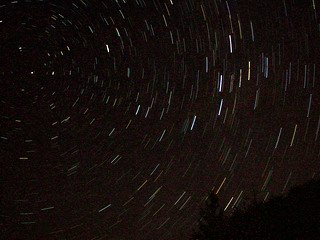
Click the
image to see high resolution photo (1024x768). |
Polaris and Cassiopea 2.8.2002
00:03-00:22 (22:03 - 22:22UT 1.8.2002)
Camera: Nikon Coolpix 995 lying on table
Objective: f=8.2mm, F=2.6
Camera resolution: 2048x1536
Exposure: 17x30s (ISO 200), Camera's NR used
Camera control: The
Force software
White balance: SUNNY
Seeing: windy, clouds, but dark
Processing: Stacked in K3CCDTools
using "If Lighter" stack operationThe
exposures were taken with period of 70s (30s
exposure, 30s internal darkframe, 10s for
internal processing and saving to Compact Flash
card). That's why stars trails are dashed.
At first I made stacking process in Corel
PhotoPaint with multi-objects with "If
Lighter" merge method. As each uncompressed
frame is almost 10MB, the work with 17 layers was
very slow - it took me about 30 minutes to load
the frames, align them and process them.
Then I modified my K3CCDTools to enable stacking
by using "If Lighter" method. Then I
processed the JPG sequence with K3CCDTools in 1
minute!
Although camera's NR (Noise Reduction) was
used (which is very efficient - see Efficiency
of Nikon Coolpix 995 Noise Reduction, some
hotpixels were visible. As hotpixels were points
and stars had trails - it was quite easy to
remove hotpixels in Corel PhotoPaint. Result
picture was resampled to XGA resolution with
adjusted gamma.
Darker parts in stars trails of Cassiopea are
caused by clouds :-(.
The stars colors are very nicely visible.
|
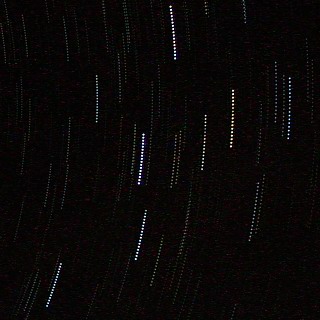 |
This is a cropped part (Cassiopea)
of high resolution1024x768 photo. |
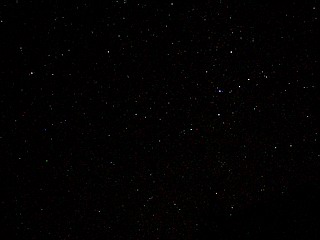
Click the
image to see high resolution photo (1024x768). |
And this is a single exposure...
for better imagination of stars |
Constellations Cygnus,
Lyra and Milky Way (31.7.2002)
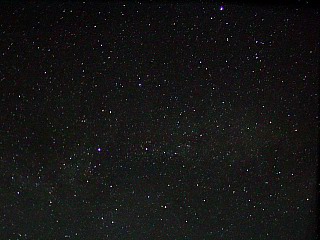
Place mouse
pointer above the photo to see the labels.
Click the image to see high resolution photo (1024x768).
Click here to see high
resolution photo with labels (1024x768). |
Cygnus, Lyra and Milky
Way, 31.7.2002 00:11-00:26 (22:11 - 22:26UT 30.7.2002)
Camera: Nikon Coolpix 995 on tripod
Objective: f=8.2mm, F=2.6
Camera resolution: 2048x1536
Exposure: 11x30s (ISO 400), Camera's NR used
Camera control: The
Force software
White balance: SUNNY
Seeing: windy, clouds, but dark
Processing: Summed in MaximDL Demo 3.0 (with
field rotation)The summed image was further
processed (gamma 1.25, histogram stretching).
The stars colors are very nicely visible (look at
high resolution photo).
Note: Border of image are darker because
of frame rotation during stack process.
|
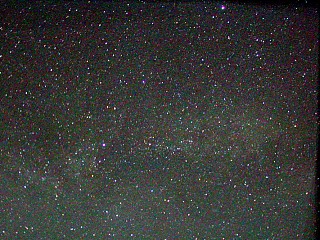
Place mouse
pointer above the photo to see the labels.
Click the image to see high resolution photo (640x480).
Click here to see high
resolution photo with labels (640x480). |
The same source as above, but
gamma=2.50 for emphasizing Milky Way. 2 arms of
Milky Way in Cygnus are visible. A hint of NGC
7000 (North America Nebula) is visible (see high
resolution photo).
|
Lyra in raw frame (31.7.2002)
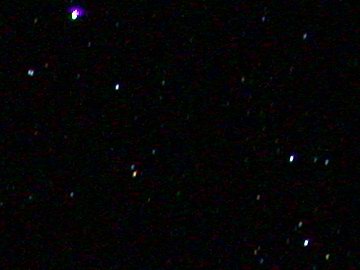 |
Detail of Lyra constellation (in
full resolution) cropped from one of frames from
above source.
Camera: Nikon Coolpix 995 on tripod
Objective: f=8.2mm, F=2.6
Camera resolution: 2048x1536
Exposure: 30s (ISO 400), Camera's NR used
Camera control: The
Force software
White balance: SUNNY
The Lyra was in the upper left corner of
frame, so some color aberration on bright Vega
star is visible. Interesting thing is, that e1 and e2 elements of
well-known Double-Double can be distinguish in
the photo (separation 3.5 arcmin)
|
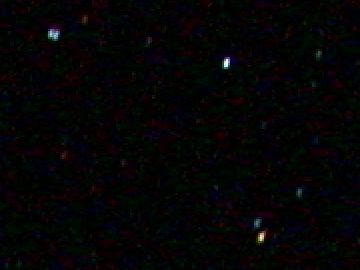 |
Here there is a 2X zoomed part
of Double-Double. |
Orion constellation (9.12.2001)
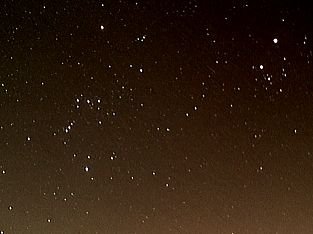
Click the
image to see full resolution photo (625x469). |
Orion constellation 9.12.2001
(02:40 2001 UT)
Camera: Philips Vesta SC with original lens on
photo tripod
Objective: f=4.5mm, F=3.0
Exposure: 8x40s (gain 80%), 8xDF
Temperature: -6°C
Captured and processed: K3CCDTools
The Orion constellation is visible on the left
side while a head of Taurus on the right site.
The bright "star" upper right from
Aldebaran is Saturn.
Sky glow at the bottom of photo is caused by
light pollution.
|
Back to Sky Page
Computer generated images,
real images, drawings and texts are property of the
author and may not be reproduced or used without
permission of author.

Last Update:
10.08.2003
|